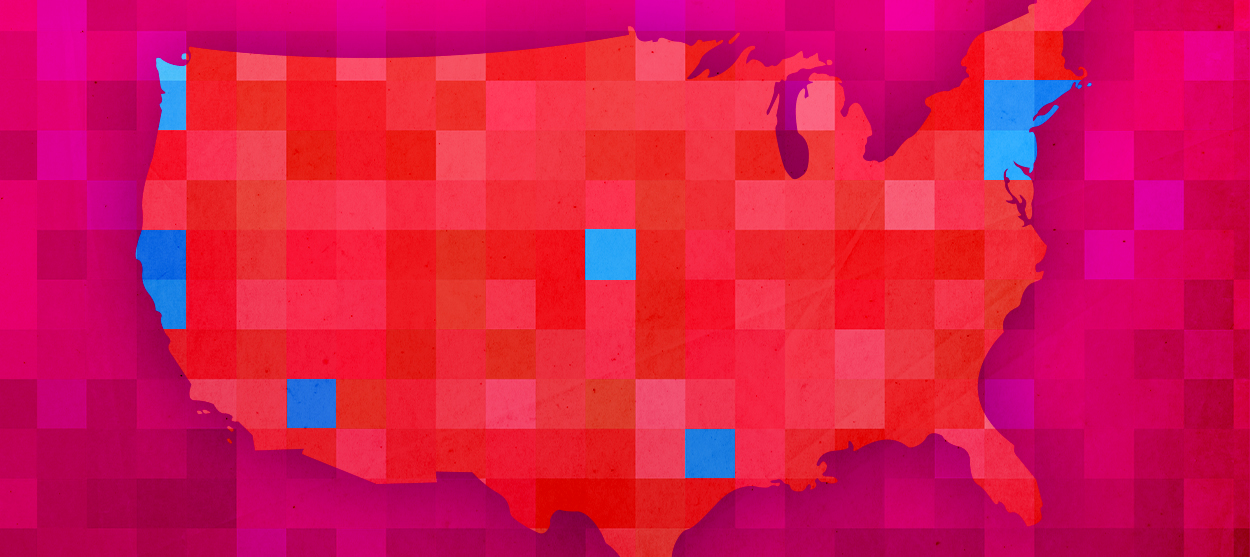How right-wing populism overcame distance
Rural America was ripe for political radicalization. Social media galvanized the movement.


There has been something keenly unnerving about the weeks since the presidential election — and not just because of Donald Trump's refusal to concede and hapless (and still ongoing) attempts to reverse its results. What's discomforting is that all of it — the president's anti-democratic antics along with the technologically intensified cheers and jeers of those defending and denouncing him — is a distressing sign that the madness of politics over the past four years is going to continue long after the Trump administration comes to an end on Jan. 20, 2021.
Why has right-wing populism risen to prominence — and why is it likely to remain a driving force in our politics?
Many point to technology (especially social media) and its tendency to undermine the authority of established institutions, spread distrust, and encourage the creation of separate epistemological universes (often called echo chambers or information silos).
The Week
Escape your echo chamber. Get the facts behind the news, plus analysis from multiple perspectives.

Sign up for The Week's Free Newsletters
From our morning news briefing to a weekly Good News Newsletter, get the best of The Week delivered directly to your inbox.
From our morning news briefing to a weekly Good News Newsletter, get the best of The Week delivered directly to your inbox.
But others are skeptical about treating technology as the primary source of our discontents. In a recent New York Times column, David Brooks pointed in a more sociological direction. Drawing on the writings of Jonathan Rauch and Will Wilkinson, Brooks highlighted the rise over the past few decades of densely populated cities and suburbs as focal points in the information economy. This has produced a gap separating these thriving regions from lower density parts of the country that are falling behind in economic, educational, and cultural terms — and voting for Trump and those like him in an act of political retaliation. Technology, in this account, is important mainly as a means of amplifying the independently constituted despair of the American heartland.
The sociological account is correct as far as it goes, but it fails to grasp the politically crucial way that social media networking interacts with the distinctive anger and frustration that prevails in economically struggling, sparsely populated regions of the country. Without that technological piece of the puzzle, it would have been much more difficult to conjure and sustain a movement of right-wing populism capable of challenging institutions of the political establishment. And with this piece of the puzzle in place, it's hard to imagine that movement dissipating.
Consider the process of political organizing in a democracy. In a densely populated urban or suburban area, large crowds of people can easily gather together physically in one place. Think of a politician, activist, or community organizer standing on a proverbial soap box or milk carton on a street corner, knocking on doors, holding protests and rallies. Such gatherings can easily attract large numbers of citizens with the shared sense of community and common interests that comes from living in the same neighborhood or city. Out of that forging of political solidarity, movements for reform can be galvanized and mobilized with relative ease.
But politics in rural areas is more challenging, especially if it aims to enact change beyond the local level. That's because rural regions are much less densely populated, with citizens often separated by vast distances that make political organizing and the forging of political solidarity quite difficult. What unites a struggling community in rural or exurban Georgia to others in Texas, South Dakota, and Oregon? Would they even conceive of themselves as belonging to a single political entity — a faction sharing common interests and passions rooted in common experiences and cultural outlook?
A free daily email with the biggest news stories of the day – and the best features from TheWeek.com
James Madison didn't think they would — and he thought this would be a very good thing. One of his biggest concerns in attempting to devise a republican system of government for the United States was the prospect of political factions forming that would be large enough to oppress other factions. The famous solution he sketched out in Federalist Paper #10 proposed that the vast size of the country would result in a proliferation of factions and interests, with none of them large or strong enough to dominate the others.
In Madison's vision, people would gather into local factions and conduct politics in counties and towns. Conglomerations of factions and interests that dominated these counties and towns would influence politics at the state level. The only factions and interests that would be felt at the level of the country as a whole, in the nation's capital, would be those few that managed to link up with others in different parts of the country, demonstrating a genuinely broad base of support.
Achieving such support was exceedingly difficult prior to the rise of communication technology — telegraph, telephone, radio, mass-market periodicals (magazines), and television. The Civil Rights Movement began after World War II in the rural American South and ended up catalyzing enormous change, but only because it gained widespread attention in national print and broadcast media, which inspired protests to spread throughout the country, activists in the North to join the movement for racial justice, and finally, politicians in Washington to pass civil rights legislation.
During the same era, conservative activists did something similar — rallying behind Barry Goldwater's failed presidential campaign in 1964, some offering cautious support for George Wallace's remarkably potent third-party populist campaign for the presidency in 1968, and many others flocking to Richard Nixon's re-election effort against George McGovern in 1972. Phyllis Schlafly's grassroots crusade to stop the Equal Rights Amendment throughout the 1970s built on this energy, helping prepare the way for Ronald Reagan's successful bid to take over the Republican Party and win the White House in 1980.
All of these movements, left and right, originated far away from urban centers and took many years of effort to gain political traction — and neither would have succeeded without technological developments that helped amplify their messages and broadcast them far beyond the places where the protests originated. The Civil Rights Movement was fueled by coverage in the mainstream media. The conservative populism of the New Right created its own media networks, first in magazines, books, and newsletters, and later in talk radio and cable news.
But that's nothing compared to what the internet has made possible.
Imagine yourself raised in rural Pennsylvania, or Ohio, Michigan, Wisconsin, Iowa, Idaho, Oklahoma, or South Carolina. You feel crushed by what deindustrialization has done to your part of the state and members of your family, devastated and tempted by the drug addiction you see all around you, confronted every day by a culture of decline and hopelessness, by the reality of a life without opportunities for bettering yourself. You're angry about it all — and about the failure of both political parties to address or even acknowledge any of it. Which means you are ripe political radicalization.
What makes the difference between potential and actual radicalism? It can be nothing more than a dawning awareness that misery and struggle in one's own life and neighborhood isn't just happening in that one place — that it's a widespread problem afflicting many other communities that resemble one's own in all sorts of ways. Awareness of misery and struggle, and the validation of indignation and blame, are cultivated and encouraged every day in chat rooms and on 4chan, Reddit, Facebook, and Twitter, where people from far-flung parts of the country build solidarity by recognizing shared experiences and indignities.
When the potent catalyst of a gifted demagogue like Donald Trump is added to the digital mix, taking constant real-time shots at those who thrive under the prevailing system and its rules, a kind of political-cultural alchemy takes place. Before you know it, people who 10 years ago would have seen themselves as having little or nothing in common, from the Midwest through the Deep South to the Intermountain West, are flying flags of unified, proud defiance: The Stars and Bars, "Don't Tread on Me," the Thin Blue Line.
That's what social media does: It allows for the constructing of identities and the cultivation of resentments in a virtual space among likeminded people separated by vast distances in the physical world. Instead of Madison's highly differentiated republic of discrete communities with their own regional, factional interests — or the kind of slow-motion grassroots organizing we saw in the real world during the mid-20th century — we have new forms of rapid-fire, technologically facilitated solidarity among tens of millions of Americans separated by hundreds or thousands of miles but united by a sense of shared grievance and a commitment to lashing out against its sources, real and imagined.
That is populist politics in action — and it is transforming the country and much of the wider world right before our eyes.
This is the first article of a two-part series on technology and populist politics. Part two can be found here.
Damon Linker is a senior correspondent at TheWeek.com. He is also a former contributing editor at The New Republic and the author of The Theocons and The Religious Test.
-
 Has Zohran Mamdani shown the Democrats how to win again?
Has Zohran Mamdani shown the Democrats how to win again?Today’s Big Question New York City mayoral election touted as victory for left-wing populists but moderate centrist wins elsewhere present more complex path for Democratic Party
-
 Millions turn out for anti-Trump ‘No Kings’ rallies
Millions turn out for anti-Trump ‘No Kings’ ralliesSpeed Read An estimated 7 million people participated, 2 million more than at the first ‘No Kings’ protest in June
-
 Ghislaine Maxwell: angling for a Trump pardon
Ghislaine Maxwell: angling for a Trump pardonTalking Point Convicted sex trafficker's testimony could shed new light on president's links to Jeffrey Epstein
-
 The last words and final moments of 40 presidents
The last words and final moments of 40 presidentsThe Explainer Some are eloquent quotes worthy of the holders of the highest office in the nation, and others... aren't
-
 The JFK files: the truth at last?
The JFK files: the truth at last?In The Spotlight More than 64,000 previously classified documents relating the 1963 assassination of John F. Kennedy have been released by the Trump administration
-
 'Seriously, not literally': how should the world take Donald Trump?
'Seriously, not literally': how should the world take Donald Trump?Today's big question White House rhetoric and reality look likely to become increasingly blurred
-
 Will Trump's 'madman' strategy pay off?
Will Trump's 'madman' strategy pay off?Today's Big Question Incoming US president likes to seem unpredictable but, this time round, world leaders could be wise to his playbook
-
 Democrats vs. Republicans: who are US billionaires backing?
Democrats vs. Republicans: who are US billionaires backing?The Explainer Younger tech titans join 'boys' club throwing money and support' behind President Trump, while older plutocrats quietly rebuke new administration



